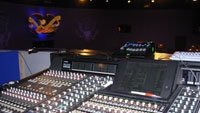Redundant audio strategy key to presidential debate security

Larry Estrin has been director of audio and production communications for the Commission on Presidential Debates since the Clinton era. He’s learned that redundancy is the key to a successful telecast. During the town hall-style debate in Nashville on Oct. 7, Barack Obama and John McCain each had their own handheld Audio-Technica AEW-T5400 cardioid condenser handheld microphone/transmitter running through an Audio-Technica 5000 series wireless system. That was backed up with an Audio-Technica AT898cW cardioid lavalier microphone. Moderator Tom Brokaw wore two of those. Waiting in the wings were identical spare handheld wireless AEW-6100s and the last line of defense against a wireless disaster: two wired AEW-6100 microphones.
At one point during the debate, a seated Sen. McCain laid his handheld microphone in his lap even as he continued speaking. “Without the lav backup there would have been no audio,” Estrin said. The lavalier channel was opened immediately by audio mixer Michael Abbott, working on a Yamaha PM1D digital console above the stage area.
Estrin knows that politicians tend to be averse to wearing wireless lavs, never knowing when they’re live, or worse. “All politicians have concerns about wearing wireless microphones because of the ability for anyone to scan the spectrum and tune in,” he said. “We go to some lengths to make that process more difficult. We change frequencies on everything after the candidates walk through in the afternoon. We do not turn on the candidate transmitters until a moment before they are introduced and go out on stage. After the debate we shut off the receivers so we or the pool cannot inadvertently send the signal out. We also turn off their transmitters as soon after the event as possible, on stage, not back in their hold rooms.”
The audio crew this year also punched up their wireless coordination, from what Estrin characterizes as “mid-level,” FCC-supervised RF coordination during the 2004 debates to a “full-blown” effort this time, including three NFL coordinators on-site tracking every possible frequency, including ones used by the Secret Service, and a complex wireless IFB system with a Lectrosonics intercom system used on the stage floor and a Riedel system communicating within Belmont University’s Curb Event Center and integrated with an HME paging system in the CBS pool trucks.
Acknowledging that this would be the last round of presidential debates before the change to digital television puts the white space in play, Estrin said frequency coordination will continue to grow in importance. “I expect that the manufacturers of wireless microphones and in ear monitor systems will develop digital audio transmission technologies from the ground up and stop trying to put band-aids on the existing technology, which has been in use for several decades.”
Get the TV Tech Newsletter
The professional video industry's #1 source for news, trends and product and tech information. Sign up below.
